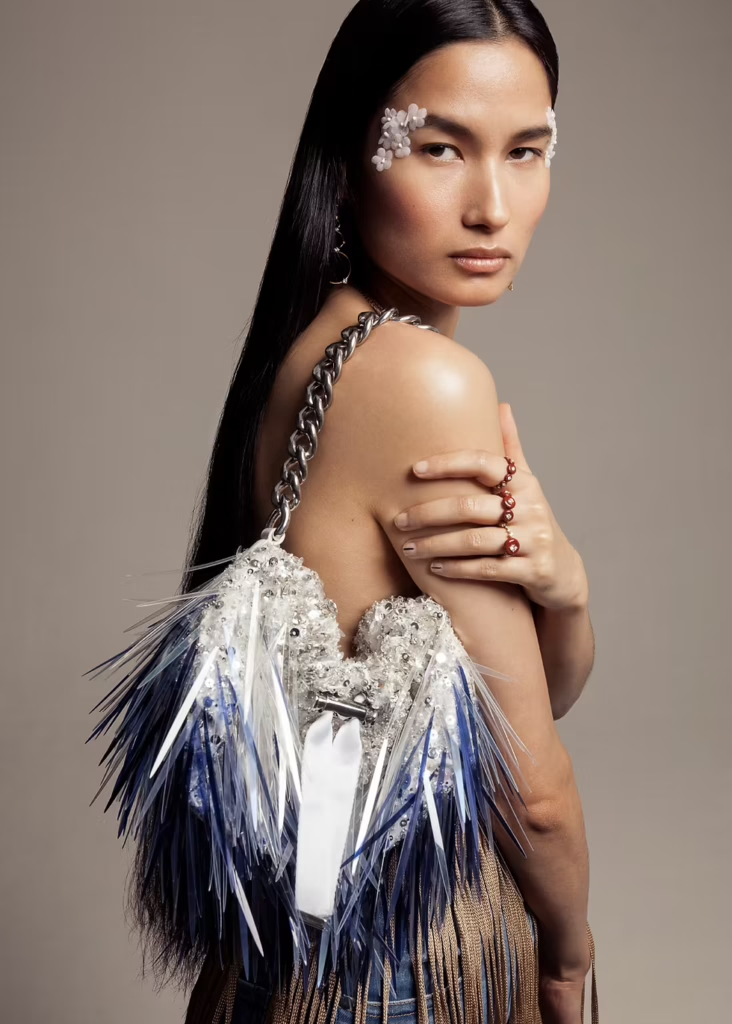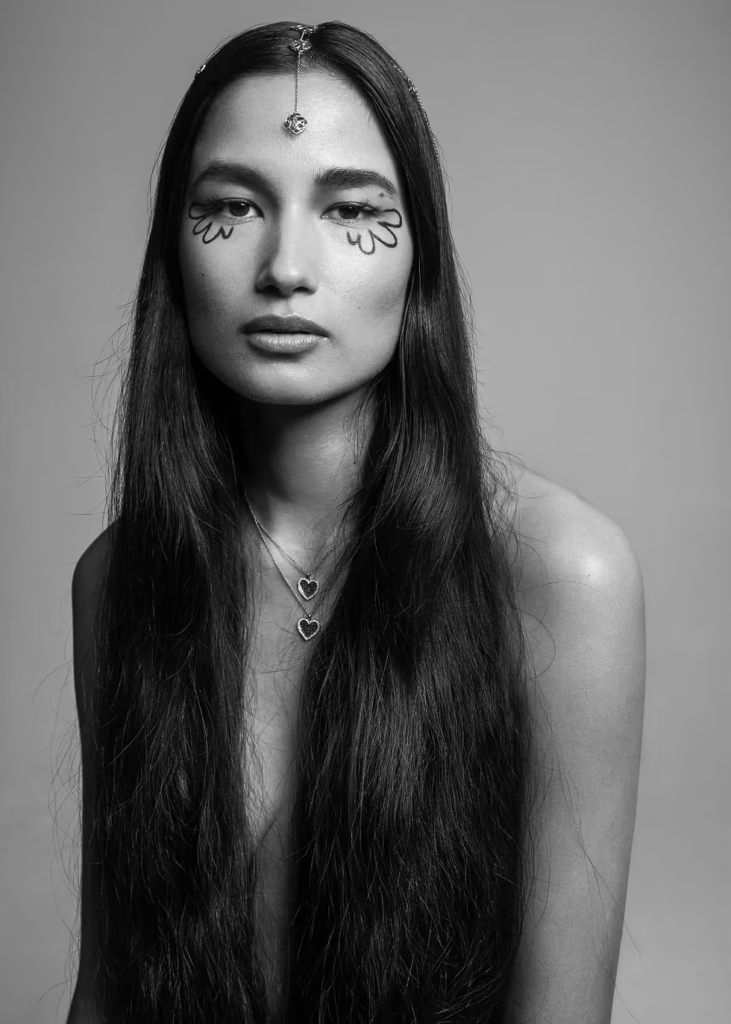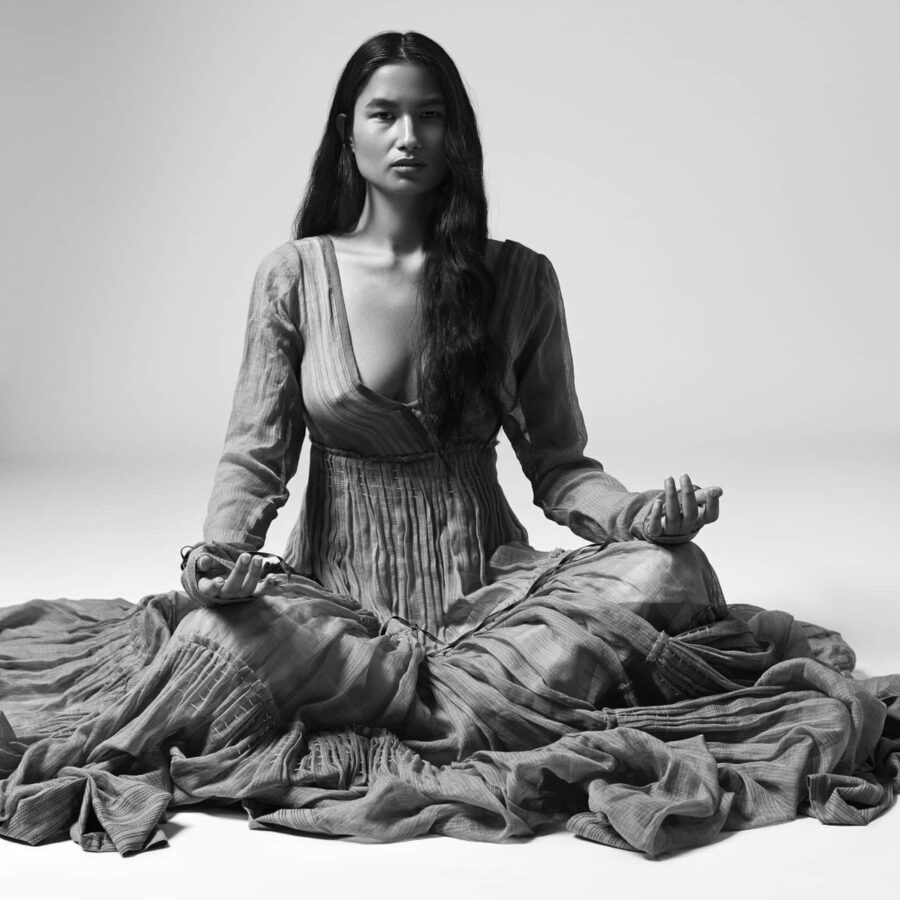Varsha Thapa stands as a singular force in the global art and fashion landscape, a figure who seamlessly blends the high-octane world of international modeling with the soulful depths of music and the unwavering commitment of activism. She is more than a model; she is a narrative in motion, a living canvas of cultural pride and personal evolution. Her journey transcends the conventional, embodying a spirit of unwavering resilience and cultural pride that resonates deeply within the arts and culture landscape. As Nepal’s pioneering international supermodel, she has not only graced global runways and prestigious magazine covers but has also carved out a significant career as a singer-songwriter and a passionate animal rights advocate. This article seeks to present a complete perspective of her multifaceted life and career, appreciating her journey as an artistic expression in itself. Indeed, her public identification in major campaigns not just as a model, but as a “singer and animal rights activist,” underscores a deliberate and powerful expansion of her public persona, setting the stage for a truly comprehensive profile.

Roots and Rebellions, The Genesis of a Dream
Varsha Thapa’s story begins in Nepal, where she was born and raised, though her formative years also included schooling in India. This bicultural upbringing provided her with a unique lens through which to view the world and her future. It was during these early years that a nascent fascination with the glamorous world of fashion took root, often finding her sneaking peeks at Fashion TV and admiring models as they strode confidently down runways. She would even reminisce about standing in front of the mirror, wondering if she could one day emulate their captivating presence.
Paradoxically, the very qualities that would later define her success in modeling, her striking height, standing tall at 5’10”, and her naturally slender frame, were initially sources of profound discomfort. She candidly recalls being bullied in school for being “different” and “the tallest kid in class,” a trait she admits “intimidated all the guys”. This early experience of feeling like an outlier, however, became an unexpected catalyst. Witnessing those tall, seemingly “free and liberated” models on television, “celebrated for who they were,” provided a powerful vision of self-acceptance. In them, she recognized herself, affirming, “I’m tall, I’m skinny, I’m beautiful. I didn’t think I lacked anything”. This pivotal moment transformed a source of insecurity into a wellspring of aspiration, demonstrating how early adversity can forge a profound sense of self-worth and a desire to find a space where one’s unique attributes are not just accepted, but celebrated.
Despite this burgeoning dream, modeling was largely perceived as a “hobby, not a profession” in Nepal, making it an unconventional career choice. Consequently, Varsha initially pursued hotel management, adhering to her mother’s wishes and plans for her future. However, halfway through college, she experienced a profound realization, stating she “didn’t want to work in the service industry”. The decision to abandon this path was “very tough,” particularly given her mother’s immense sacrifices and hard work to fund her education. This early act of defiance against external expectations, driven by an internal conviction, highlights her nascent determination and the significant personal cost of pursuing an unconventional dream, setting the stage for the fierce independence she would later cultivate.

The Concrete Jungle, Trials and Triumphs in New York
In 2011, Varsha Thapa landed in New York with a contract from Wilhelmina Models, one of the world’s largest and most successful modeling agencies. She initially believed her career path would be a “cake walk”. However, the reality of the industry was starkly different. She quickly learned that the agency was “merely a medium,” and securing jobs depended “entirely on her”. As a newcomer, she faced significant financial burdens, as the agency billed her for essential headshots, photos, and comp cards, business cards models use to present themselves, with these costs charged directly to her account.
Despite walking for prestigious events like New York Fashion Week and Paris Fashion Week, Varsha was often “broke”. The glamorous facade of international modeling often conceals severe financial hardship and personal sacrifices, particularly for emerging talent. To survive and maintain her presence in the fashion capital, she took on side jobs in retail, folding clothes, and even worked as a greeter for Abercrombie & Fitch, standing at the door in a bikini. In a candid admission, she revealed she would go out with club promoters for decent meals, in exchange for dancing for a few hours for the club’s publicity, simply because she had “no other way to have a good dinner”. This period was “very hard,” demanding that she “show everyone that I was okay” and diligently maintain her body, all while facing immense private hardship. This experience reveals the systemic financial pressures within the industry that forced her to maintain a facade of success despite her personal struggles.
Through sheer grit and unwavering determination, within three years, Varsha managed to pay off her accumulated debt and amass $10,000 in cash, finally feeling “free and could do what she wanted to”. This hard-won financial liberation marked a pivotal turning point in her career. Post-debt, she strategically switched agencies multiple times, eventually finding a home with The Lions, a smaller modeling agency that offered her “more freedom to do the kinds of jobs she wants”. This strategic move reflects her growing power and discernment in her career, demonstrating how gaining financial independence allowed her to gain greater autonomy and align with agencies that supported her personal and professional vision. The intense financial and emotional pressures in New York forged her resilience, leading to significant personal growth and a honed sense of determination that became central to her enduring success.

Gracing the Global Stage, A Fashion Force
Varsha Thapa rapidly built an impressive resume after her international runway debut at the Spring/Summer 2012 New York Fashion Week. In just nine years since starting her career in 2011, she established a remarkable portfolio, walking for major fashion weeks across the globe, including Paris, Milan, and Lakme Fashion Week. Her early work included acclaimed designers like Phillip Lim and the late L’Wren Scott.
Her portfolio boasts features in top fashion publications such as Vogue, Cosmopolitan, Elle, and Harper’s Bazaar. Her client list includes prestigious global brands like Dolce & Gabbana, Nike, Hermes, Ralph Lauren, Bottega Veneta, and Mugler. She also secured significant campaigns for Missoni and BCBGMaxAzria, and more recently, the ARKET Fall/Winter 2023 campaign, showcasing her sustained relevance and adaptability in the competitive industry. Her swimwear shoot for Missoni on South Beach in Miami was a particular career highlight, fondly recalled as feeling like a “mini vacation” due to the amazing weather.
A defining and celebrated aspect of her public image is her “lacha dhago” (ribbon braids), a traditional Nepali accessory. She famously flaunted it at Vogue in 2018, leading to a dedicated article titled ‘Meet the Nepalese Model Whose Ribbon Braids Are a New York Street Style Phenomenon’. She consistently wears her dhago in music videos, campaign shoots, and Instagram posts, consciously weaving her heritage into her global persona. This transformation of a personal cultural accessory into a “New York Street Style Phenomenon” and a Vogue feature illustrates her profound impact on mainstream fashion, demonstrating how individual cultural expression can become a powerful statement of identity and a catalyst for broader cultural appreciation within the art world, blurring the lines between personal heritage and global trendsetting.

The Gurung Connection, A Bond Forged in Heritage
Varsha Thapa’s connection with Nepalese-American designer Prabal Gurung is a cornerstone of her career and a powerful symbol of national pride on the global stage. She first walked for Gurung in 2012, early in her international career. Their meeting was a momentous occasion for both; Gurung was “thrilled” to encounter a Nepali model on that platform, having never met one before. This serendipitous encounter was, for Varsha, her “life’s biggest achievement,” particularly because she was the “first Nepali international model walking for the first Nepali international designer”. This shared heritage created an immediate and powerful bond that transcended a typical designer-model relationship, fostering a unique partnership that became a symbol for Nepali representation.
Since their initial collaboration, they have worked together multiple times, forming what is widely recognized as an “iconic Nepali pair in New York: the star designer and his fabulous model”. Their bond extends beyond professional collaboration to a shared appreciation for Bollywood, which further cemented their personal connection. Varsha views Gurung as a “really good person” and “very inspiring,” expressing profound admiration for “everything he’s done for Nepal”.
Both Thapa and Gurung are fierce advocates for diversity and representation in the fashion industry. Gurung has actively recruited all-Asian casts for his campaigns, describing them as “A love letter to our home, the East”. He passionately believes that “strong visual representation for minority groups is more important than ever,” a sentiment deeply shared by Varsha, given her own experiences with racism in the industry. Her direct experience provides an authentic voice for her involvement in diversity and inclusion campaigns.
A notable collaboration showcasing their shared vision was Varsha Thapa’s prominent feature in the iMPOWER by Prabal Gurung for JCPenney collection campaign, photographed by legendary Norman Jean Roy. This collection was explicitly designed as a “joyful tribute to the power and resilience of the female spirit” and a “celebration of diversity, inclusion and optimism,” aiming to bring “affordable luxury” and “inclusion in every size, every color” to a broader, more diverse audience. Thapa’s participation in such a high-profile commercial endeavor underscores her commitment to accessible and inclusive fashion, aligning her personal values with her professional work and demonstrating her active role in shaping a more equitable fashion landscape.

Beyond Beauty, Championing Inclusivity and Change
Varsha Thapa has candidly spoken about the pervasive racism she encountered early in her career within the fashion industry. She openly notes that “Most jobs go to white girls and there’s maybe one or two slots for a black girl and an Asian girl. And even the Asian slot goes to an East Asian girl”. This systemic bias meant that before her major breakthrough, she often had to accept “the leftover jobs that no one wanted to do”. Her personal struggle provides a powerful foundation for her advocacy, transforming individual adversity into a platform for broader industry change.
Her historic Vogue India cover in October 2016, part of a feature titled ‘Celebrating Beauty in Diversity,’ was a significant moment where she expressed profound gratitude for conveying “such a powerful message to the world about empowering #beauty of #diversity!” She openly acknowledged the inherent difficulty for “ethnic models to make it big” in the industry. She firmly believes that “strong visual representation for minority groups is more important than ever,” reflecting a sentiment she shares with Prabal Gurung. Her consistent presence on international runways and in major campaigns, particularly with her “lacha dhago,” serves as a visible statement of cultural pride and diversity, actively breaking barriers and creating space for women who look like her. This demonstrates her understanding that her influence extends beyond fashion and into social impact.
Varsha’s journey is a powerful testament to her unwavering belief in herself and her ability to overcome obstacles. She lives by the mantra, “If you feel stuck, cut off the anchor that’s pulling you back”. She consistently emphasizes the critical importance of “hard work and determination” and the belief that “perseverance wins you half the battle. The rest is your skills and the value you bring to the culture”. She is committed to actively “breaking the barriers and entering spaces where women who look like me do not exist yet and create space for them”.
While her primary activism is not centered on sustainable fashion, her awareness and alignment with this growing industry trend are evident. During a CFDA Fashion Fund challenge, where designers used sustainable fabrics, she noted, “I love tie-dye and like the fact that it’s sustainable, it’s the future”. This indicates a forward-thinking perspective on ethical fashion, demonstrating her adaptability and a holistic awareness of the industry’s broader social responsibilities beyond just representation.

Harmonies of the Soul, Varsha Thapa, the Musician
Varsha Thapa’s connection to music is deeply rooted in her childhood. She has “always loved music ever since I was a kid,” growing up listening to old Nepali and Indian classical music played by her parents on their cassette player every morning. This early exposure “shaped how I saw the world” and transported her to “another realm”. Later, during her boarding school years, she began writing self-motivating poetry as a coping mechanism for bullying and loneliness. Over time, she started adding melodies to these words, transforming her personal struggles into a natural form of musical expression. This evolution highlights how her music is not merely a side project but a profound extension of her artistic expression and a therapeutic outlet for past trauma. She officially started performing and writing songs after forming her band, Sita Virgin, in New York in 2018.
Her music is profoundly influenced by the rich tapestry of old folk music from Nepal (1950s-70s artists like Narayan Gopal, Tara Devi) and classic Hindi cinema music (R.D. Burman, Kishore Kumar, Mohammad Rafi, Asha Bhoshle, Lata Mangeshkar). She consciously tries to capture the “era and its nostalgia” in her music. Additionally, she draws inspiration from Western artists like Pink Floyd, Radiohead, Frank Ocean, Mazzy Star, and Bjork. This diverse palette allows her to create a unique “amalgamation” of Eastern and Western sounds, reflecting her bicultural identity and global journey.
Her songs communicate a range of profound emotions and introspective themes, including love, heartbreak, and self-discovery. Her first single, “Maaya” (meaning “love” in Nepali), emerged from a dream-like state, recorded upon waking, reflecting her emotional depth and spontaneous creative process. “Damaged Planet” is a politically charged song addressing environmental concerns, but also metaphorically explores themes of love and loss, and crucially, the importance of self-love. It serves as a powerful reminder that “the self is a home that needs love, care, and nourishment”. “Aansu Ko Varsha” (meaning “Rain of Tears” in Nepali) is an instrumental piece that she loves for its ability to perfectly encapsulate melancholic and mellow dramatic emotions, building to a cinematic climax. It is also described as a moving ode to her late grandmother, showcasing her ability to convey deep emotion without words. This thematic depth demonstrates that her music is a direct, profound reflection of her inner world and life experiences.
Varsha has a long “bucket list” of musical aspirations, stating there are “Too many to count in both hands”. These include performing for a crowd, continuously getting better as a musician, experimenting with different sounds, releasing more music, collaborating with other artists, and simply growing every day as an artist.

A Heart for Humanity, Activism and Purpose
Beyond her prominent careers in fashion and music, Varsha Thapa is a deeply committed animal rights activist. She actively supports “Animal Nepal,” an organization dedicated to helping stray animals, including cows, calves, dogs, and cats, by fostering them and putting them up for adoption. This consistent dedication to animal welfare goes beyond mere endorsement; it is a hands-on commitment to a cause that aligns with her compassionate nature.
Her commitment extends to tangible initiatives. In December 2022, she collaborated with “MotoPaws” in Nepal, a non-profit that creates reflective collars for stray dogs to prevent them from being run over by vehicles, particularly at night. This demonstrates a practical and compassionate approach to philanthropy, showing a genuine, active commitment to a cause that reflects a core personal value.
This dedication to animal welfare aligns perfectly with her broader personal philosophy of “giving back, as we continue to receive from the world”. This ethos was also evident in her earlier efforts to raise funds for victims of the devastating 2015 Nepal earthquake, showcasing a consistent, deeply ingrained commitment to her homeland and its well-being. Her description of Nepal as having a “maternal, loving energy,” in contrast to the “paternal, business-focused energy” of cities like New York, further contextualizes her compassionate nature and desire to contribute positively. Her public profile from modeling and music gives her a platform, and she consistently leverages this visibility and her resources to make a tangible difference in her home country, moving beyond just fashion and into broader social impact.

An Enduring Legacy of Authenticity
Varsha Thapa’s journey is a compelling narrative of a trailblazer who defied expectations, overcame profound adversity, and carved out a unique and impactful path across the global fashion and music industries. From being a bullied child in Nepal who found solace and aspiration in the images of liberated models, to becoming an international icon, she remains deeply connected to her roots, using her platform to uplift others and champion vital causes.
Her career is a testament to resilience, illustrating how early struggles with bullying and financial hardship in a demanding industry forged an unyielding determination and self-reliance. She transformed personal challenges into a powerful drive for self-definition and professional autonomy, ultimately gaining the freedom to shape her own trajectory. Her ascent in fashion, marked by prestigious campaigns and magazine covers, is interwoven with her profound impact on cultural representation, particularly through the global recognition of her “lacha dhago.” This demonstrates how her personal identity has not just been showcased, but has actively influenced and diversified mainstream fashion.
Beyond the runway, Varsha Thapa’s artistry extends into music, where her deeply personal songs, infused with a unique blend of Eastern and Western influences, serve as a therapeutic outlet and a vehicle for self-discovery and social commentary. This multi-faceted creative expression underscores her refusal to be confined to a single medium, showcasing her holistic approach to art and life. Her unwavering commitment to animal welfare and her “giving back” philosophy further solidify her legacy as a compassionate humanitarian who leverages her visibility for tangible social good.
Varsha Thapa stands as a powerful example of authenticity, resilience, and the transformative power of self-belief. Her commitment to “breaking the barriers and entering spaces where women who look like me do not exist yet and create space for them” ensures her continued influence. Her story is not merely a chronicle of achievements but a vibrant, unfolding canvas that inspires future generations of artists and changemakers, particularly those from underrepresented backgrounds, to embrace their unique identities and live lives of profound purpose and impact.









